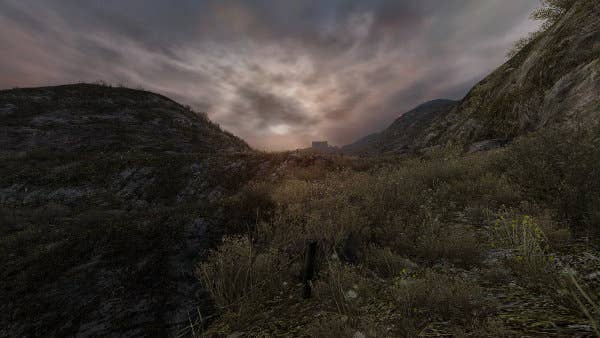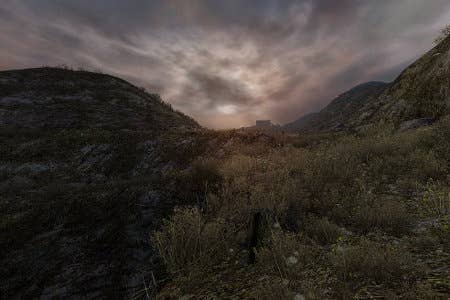Back To The Source: Dear Esther Reborn
Rob Briscoe explains how he wrung Dear Esther's potent aesthetics from the Source engine
Dear Esther, a commercial refurbishment of a celebrated Half-Life 2 mod, has been making headlines this past week. Partly because of rapid sales that saw its modest team recoup its investment in a matter of hours, and partly because nobody quite knows whether it's a game or not. Abstract, opaque, heady - few games have ventured into the territory that Dear Esther prowls so confidently, and fewer still find an audience.
What is certain, however, is that its moody narrative is etched into a landscape of unusually sumptuous design. We sat down with Rob Briscoe, a former Mirror's Edge artist and the man behind Dear Esther's high-fidelity visual refit, to talk about his tricks and tactics in wrangling Valve's Source engine.
At the time I started it, there wasn't much of a choice to be honest. There wasn't a Unreal Development Kit, Unity was still in its early stages. This is just before Christmas 2008 - there really wasn't much around at the time. It was really more about picking the engine which had the biggest modding scene. And there wasn't much competition - Half-Life 2 had the biggest installed base. But we also had a dedication to the modding scene from the original as well, which was born out of the Source engine modding scene.
But I have to say I did consider it around the time that the UDK got announced - which was around the time I finished the very first level. August 2009, I think. It was very tempting, particularly because I'd been working with Unreal for quite some time with Mirror's Edge and stuff, and I knew what it was capable of. I had been struggling with the Source engine a bit, at that point. But I think it got to a stage where I'd established the art style and look of it in the Source engine - and at the time it was just a fun side project that wasn't actually intended to go indie at that point either, so it just made sense to stick with Source.

I was planning to take some time out from the games industry after Mirror's Edge, just to spend some time with my family in the UK and plan my next move. The remake of Dear Esther really just came out of me wanting to do something creative to keep myself fuelled in the mean time. But I was only planning to do it for a year to start with.
When I was about half way through it. I had just finished off the caves level and I'd shown off a bunch of media from that, and we'd been getting a surprising amount of feedback from the modding community saying that we should really be taking it to Valve to get a licence to make it into a standalone game.
I was against that to begin with, because it was just a fun project I was doing in my spare time, and to take it commercial would turn it into this really big serious commitment. But then I thought, yeah, if there's any possibility of getting a licence then it might be worth doing. Dan [Pinchbeck, designer of the original mod] then approached Valve to see what our chances were, and fortunately they really, really liked the project. It took us quite a while to negotiate something with them that was indie friendly. But as soon as we'd sorted something out with them we took it from there.
No, we're not allowed to say, because they do it on a case-by-case basis. Ours was quite a special case because we had no money. We were like: please can we have your engine? We'll be your friend. I think they took pity on us and ended up giving us quite a good deal.
The mix of real and surreal defines Dear Esther. There's no HDR, motion blur or JJ Abrams lens flare. It's a very naturalistic but painterly look
Exactly. It still cost us quite a bit of money. We still had to go out and get funding, but they were genuinely quite supportive of us.
The aesthetic was really set by the technical limitations of the engine, initially - and that was probably one of the best things that happened to the project.
Originally, I was under the illusion that the only way to build upon the mod, and really draw people into the visuals, was to make it as photorealistic as possible. And I hit a bit of a snag early on in the Source Engine - I couldn't use any normal mapping or anything like that on the outdoor environments, because it was a performance killer. The Source engine just doesn't do outside environments very well, and this led me to rethink the photorealistic approach, and I ended up going back and doing a much more illustrative approach.
I looked at a lot of impressionist paintings and I really liked the mix of real and surreal and mix of detail and perceived detail. And it's so easy to lose yourself in those paintings, it made me realise that immersion doesn't have anything to do with photorealism at all. So that's what drove me to the visual style - the mix of real and surreal that defines Dear Esther. There's no HDR, motion blur or JJ Abrams lens flare. It's a very naturalistic but painterly look.

Definitely. From a distance you have those muted colours of the landscape, but then you have this vibrant colour in the sky, and as you get closer to the details you find colours hidden in the landscape, creating a contrast with the desaturated look of the middle-distance. It makes the world come alive on inspection. And that look has been born from the limitations of the Source engine, and it probably wouldn't have happened if I'd gone straight for the Unreal engine.
Yeah, again, technically Source forced me to do a lot of cheating, in both the visuals and the level design. The whole island had to be designed so that you can't see certain parts of it when you're in other parts, so you've got this kind of occlusion going on. But that did allow me to be a bit more creative with the environments as well.
I don't think the symbolic, surreal second half would have been as easy to pull off if I'd gone for photorealism. Here you've got a dreamlike quality. You're not quite sure if the island's real or a figment of the protagonist's imagination, so the art-style does play into that.
